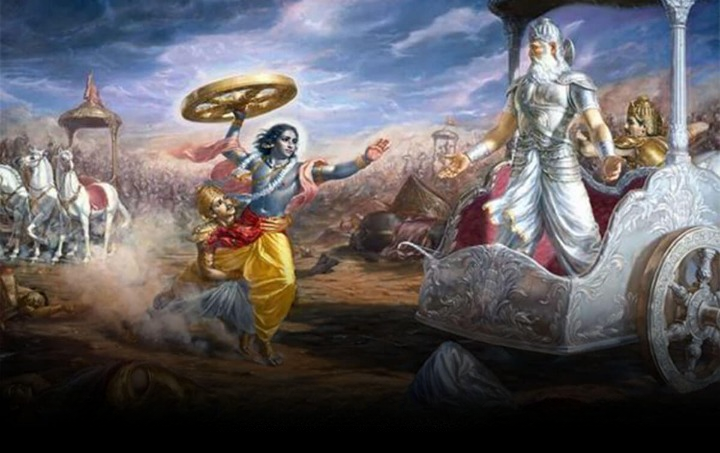.jpg )
With its rich tapestry of beliefs and philosophies, presents a unique understanding of time. Rather than viewing it as a linear progression, it envisions it as a cyclical journey divided into 4 Yugas of Hinduism, each with its own characteristics and moral standing. These Yugas, known as Satya Yuga, Treta Yuga, Dwapara Yuga, and Kali Yuga, offer a fascinating glimpse into the evolution of humankind and the underlying forces shaping our world.
Satya Yuga, literally translating to the Age of Truth, is considered the ideal era. Characterised by harmony, righteousness, and spiritual purity, it's often depicted as a golden age where humans lived for thousands of years, free from disease and suffering. Morality reigned supreme, people adhered to Dharma (righteousness), and divine beings freely walked among them.
In Satyug, Lord Vishnu had to reincarnate four times to maintain cosmic balance and uphold dharma (righteousness). These incarnations are known as the Dashavatara, and each avatar served a specific purpose:
People live long, virtuous lives, blessed with immense knowledge and wisdom. During this epoch, Vishnu manifests in four powerful forms
Matsya (The Fish): Rescues Manu, the progenitor of humanity, from a devastating flood, ensuring the continuation of life.
Kurma (The Tortoise): Supports Mount Mandara during the churning of the cosmic ocean, facilitating the emergence of the elixir of immortality, Amrita.
Varaha (The Boar): Restores Earth from the clutches of the demon Hiranyaksha, who had plunged it into the ocean depths.
Narasimha (The Lion-Man): Protects his devotee Prahlada from the tyrannical rule of his demon father, Hiranyakashipu, Lord Vishnu took Narasimha Avatar.

The Treta Yuga, or the Silver Age, marks the first subtle decline from the idealistic Satya Yuga. While Dharma remains prominent, a slight decrease in righteousness is observed. Humans still live for hundreds of years, but materialism and selfishness begin to creep in. Stories like the Ramayana, with its depiction of Rama's fight against evil, are said to have taken place during this era.
Vamana (The Dwarf): Outwits the arrogant King Mahabali, restoring balance to the cosmos.
Parashurama (The Warrior): Upholds righteousness by purging the earth of corrupt and tyrannical Kshatriya rulers. Lord Vishnu took Marishi Parashurama Avatart
Rama (The Ideal King): Embodies ideal leadership, selflessness, and devotion to Dharma, setting a timeless example.
The events of the Ramayana took place primarily during the Treta Yuga. This epic tells the story of Lord Rama, an incarnation of Lord Vishnu, and his journey to rescue his wife Sita from the demon king Ravana. It is a tale of love, devotion, and the triumph of good over evil, set in the ancient kingdom of Ayodhya.

Also Read: The Vamana Avatar of Lord Vishnu
In the Dwapara Yuga, or the Bronze Age, the decline in Dharma becomes more evident. Moral values weaken, desires and ambitions intensify, and humans live for shorter periods. This era witnessed significant advancements in technology and knowledge, alongside stories like the Mahabharata, showcasing both noble heroes and cunning villains.
Balarama (The Elder Brother): Known for his immense strength and wisdom, Balarama supports his brother Krishna in upholding Dharma.
Krishna (The Divine Statesman): Guides humanity through complex moral dilemmas, showcasing the path of love, devotion, and selfless action.
Dwapara Yuga saw the birth of Lord Krishna in Mathura and the Mahabharata War between the Pandavas and Kauravas. During this time, Lord Krishna imparted the Bhagavad Gita's timeless wisdom to Arjuna. With Lord Krishna's departure, Dwapara Yuga came to an end.

Read: The Varaha Avatar of Lord Vishnu
We currently reside in the Kali Yuga or the Iron Age. Characterised by conflict, ignorance, and materialism, it's considered the most challenging of the four Yugas. Dharma is at its lowest point, greed and negativity prevail, and humans experience the shortest lifespans. Despite its negativity, the Kali Yuga is also believed to be a time of spiritual awakening and preparation for the next cycle.
Dharma stands at its lowest ebb, marked by greed, deceit, and materialism. Yet, hope remains:
Kalki (The Future Avatar): Prophesied to arrive at the end of this Kali Yuga, Kalki restores Dharma and ushers in a new golden age.
The cyclical nature of the Yugas holds profound implications for understanding human existence. It emphasises the impermanence of all things, including societal structures and moral values. It also suggests that even during the darkest times (like the Kali Yuga), the potential for progress and spiritual evolution remains.
While the Yugas offer a broad framework, individual karma, and choices influence personal experiences within each era. This understanding inspires individuals to strive for personal growth and adherence to Dharma, regardless of the external environment.
The four Yugas in Hinduism provide a compelling narrative about time, morality, and the human condition. While the Kali Yuga presents challenges, it also holds the potential for individual and collective transformation. By understanding this cyclical journey, we can remain hopeful, make conscious choices, and contribute to a brighter future for ourselves and society.
While some interpretations consider the Yugas literal, many scholars view them as symbolic representations of cyclical trends in human history and consciousness.
Though exact timelines vary, Kali Yuga is predicted to last several thousand years. Its conclusion marks the beginning of a new Satya Yuga, restarting the cyclical journey.
Focus on personal spiritual growth, practice Dharma, and strive for positive actions. These efforts can create ripples of positive change, contributing to a better future for all.
Recognizing the challenges of Kali Yuga can motivate individuals to stay vigilant, cultivate inner strength, and make conscious choices based on ethical values.
Numerous sacred texts like the Bhagavad Gita and various Puranas explore the concept of Yugas. Consulting reputable scholars and practitioners can offer deeper insights into their interpretations and significance.
For more Interesting topics follow us on Instagram
Author :